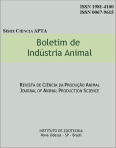Determination of the lysine level on initial-II growing phase, through chemical composition and iessues deposition and finishing effects, in swines
Keywords:
ash, lipid, protein, water, weaned pigletsAbstract
Thirty commercial hybrid pigs, barrows and females were sampled from a performance experiment and slaughtered to determine the chemical composition of the body fractions and rates of protein and lipidic deposition in carcass and empty body. Fifteen animals were slaughtered at the end of the nursery phase, after being submitted to the lysine levels 0.80, 0.90, 1.00, 1.10 and 1.20%. Other fifteen animals were slaughtered at the end of the finishing phase, after receiving diets with similar characteristics and nutritional values in the growing and finishing phases. There were no effects in the chemical composition of the offal and blood, characterising independence of lysine levels. As lysine levels increased there was positive effect on the percentage and deposited protein on the carcass and empty body. There was linear reduction in the lipid percentage of carcass and empty body; and body lipidic deposition. The increase of lysine levels led to higher efficiency in the utilisation and directioning of lysine for protein synthesis of the skeleton muscles. There were no effects of lysine levels on the chemical composition and deposition rates at 95.3kg of live weight. These linear results in body composition and deposition showed that the lysine levels must not be lower than 1.20% for piglets between 10.5 and 19.7kg suggesting new evaluations with levels higher for determine the maximum protein deposition.
Downloads
Downloads
Published
Issue
Section
License
Os autores não serão remunerados pela publicação de trabalhos, pois devem abrir mão de seus direitos autorais em favor deste periódico. Por outro lado, os autores ficam autorizados a publicar seus artigos, simultaneamente, em repositórios da instituição de sua origem, desde que citada a fonte da publicação original seja Boletim de Indústria Animal. A revista se reserva o direito de efetuar, nos originais, alterações de ordem normativa, ortográfica e gramatical, com vistas a manter o padrão culto da língua e a credibilidade do veículo. Respeitará, no entanto, o estilo de escrever dos autores. Alterações, correções ou sugestões de ordem conceitual serão encaminhadas aos autores, quando necessário. Nesses casos, os artigos, depois de adequados, deverão ser submetidos a nova apreciação. As opiniões emitidas pelos autores dos artigos são de sua exclusiva responsabilidade. Todo o conteúdo deste periódico, exceto onde está identificado, está licenciado sob a Licença Creative Commons Attribution (CC-BY-NC). A condição BY implica que os licenciados podem copiar, distribuir, exibir e executar a obra e fazer trabalhos derivados com base em que só se dão o autor ou licenciante os créditos na forma especificada por estes. A cláusula NC significa que os licenciados podem copiar, distribuir, exibir e executar a obra e fazer trabalhos derivados com base apenas para fins não comerciais.













